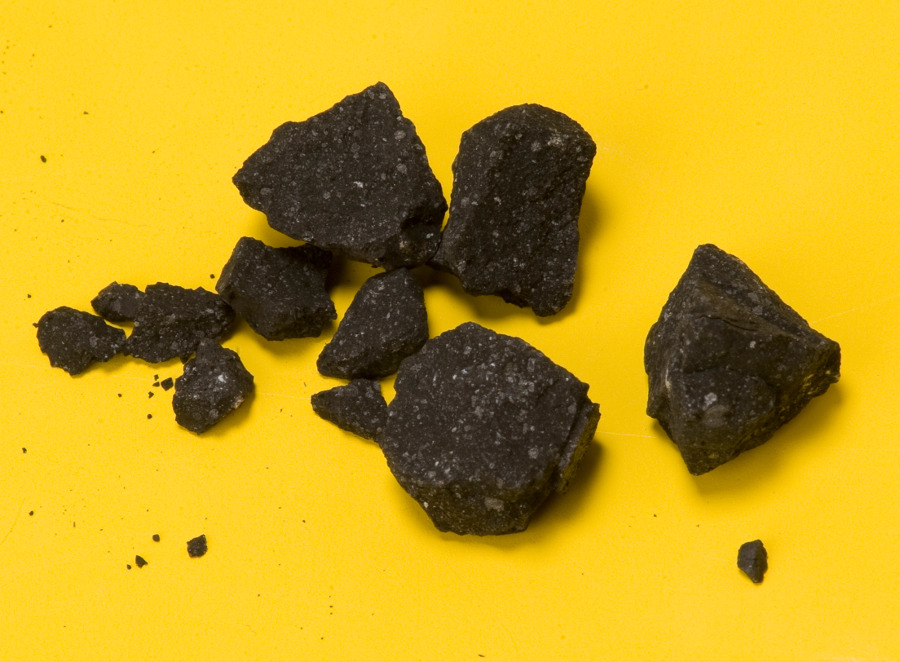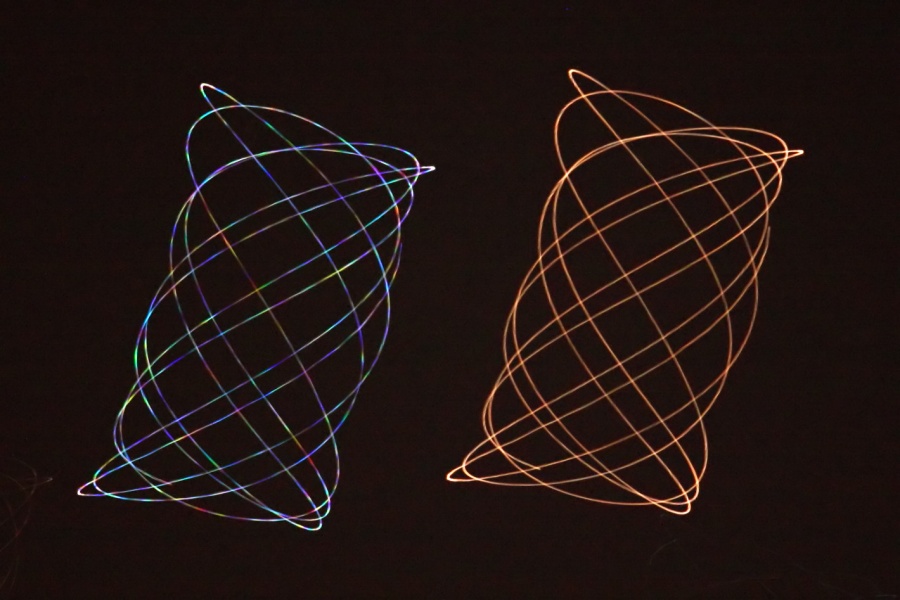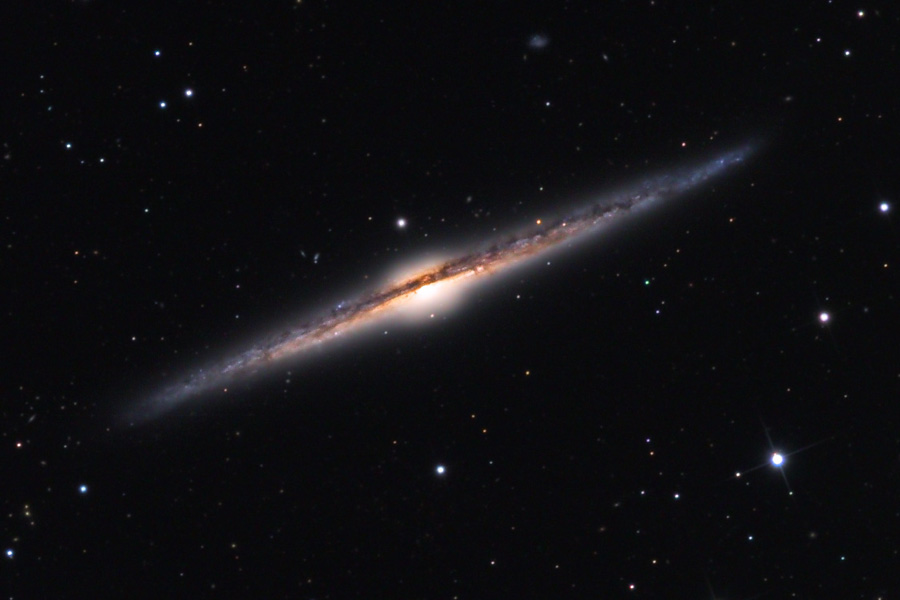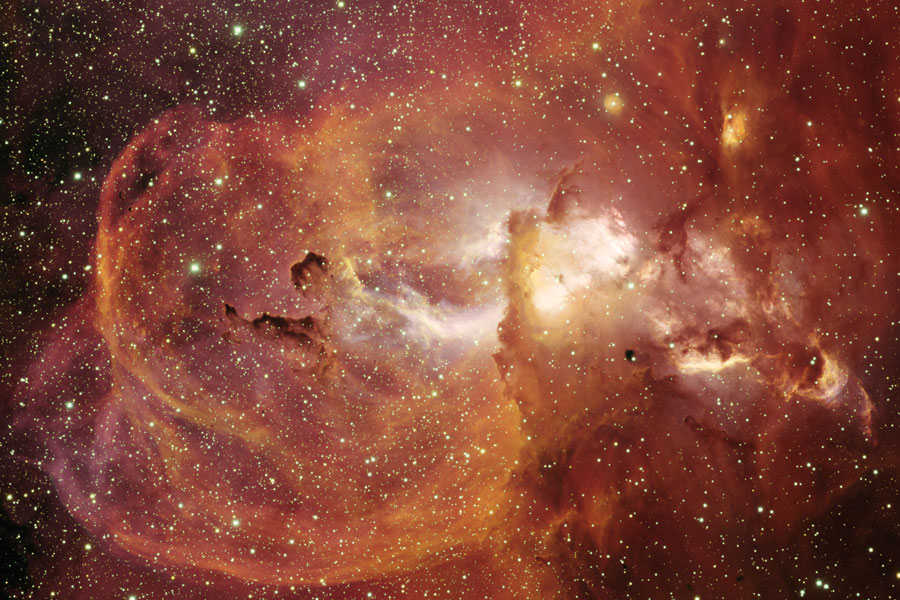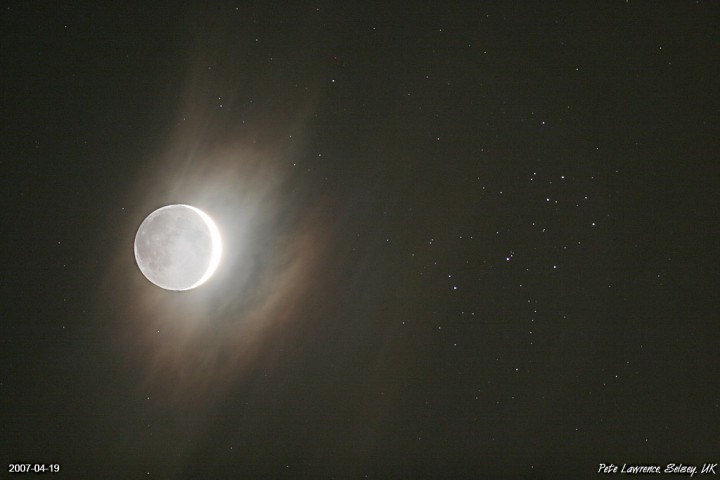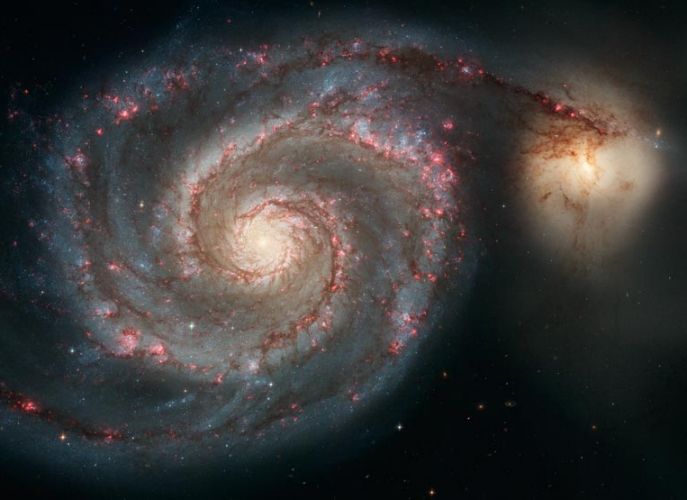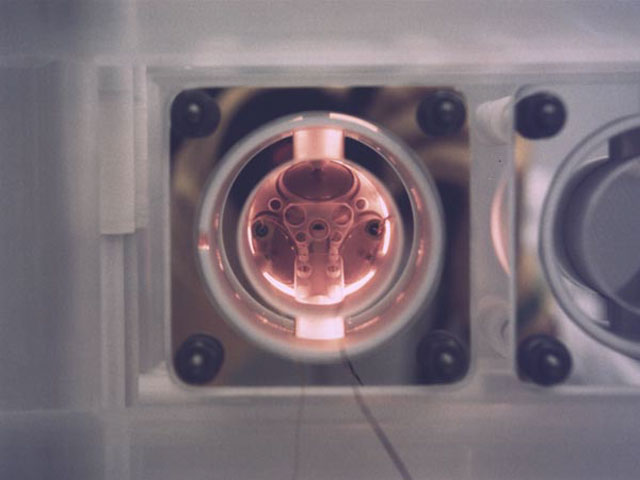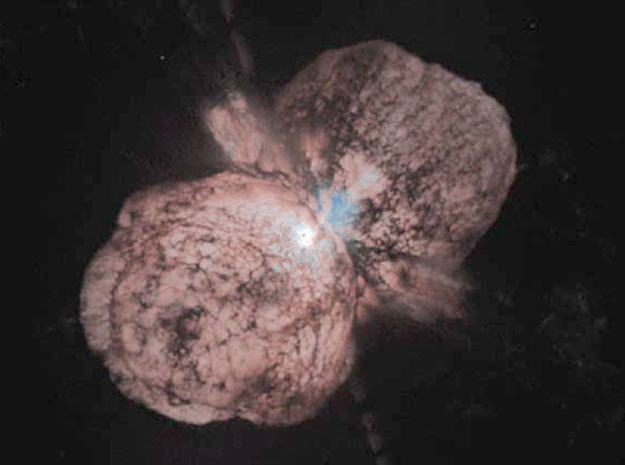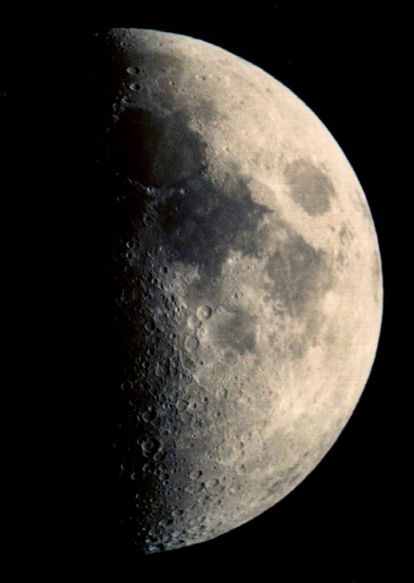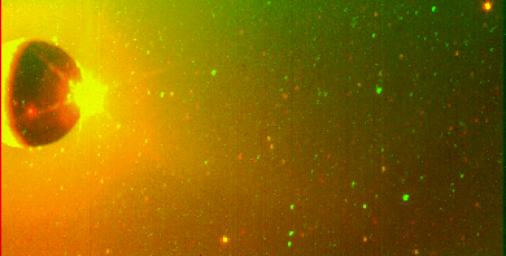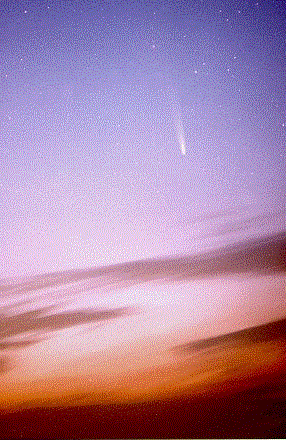| << Previous | Index | Next >> |
2015 It is one of the more massive galaxies known. A mere 46 million light-years distant, spiral galaxy NGC 2841 can be found in the northern constellation of Ursa Major. This sharp view of the gorgeous island universe shows off a striking yellow nucleus and galactic disk. Dust lanes, small, pink star-forming regions, and young blue star clusters are embedded in the patchy, tightly wound spiral arms. In contrast, many other spirals exhibit grand, sweeping arms with large star-forming regions. NGC 2841 has a diameter of over 150,000 light-years, even larger than our own Milky Way and captured by this composite image merging exposures from the orbiting 2.4-meter Hubble Space Telescope and the ground-based 8.2-meter Subaru Telescope. X-ray images suggest that resulting winds and stellar explosions create plumes of hot gas extending into a halo around NGC 2841.
2014
Click to play embedded YouTube video.
Video Credit: Adam Block, Mt. Lemmon SkyCenter, U. Arizona
2013 It was one of the largest and longest lived storms ever recorded in our Solar System. First seen in late 2010, the above cloud formation in the northern hemisphere of Saturn started larger than the Earth and soon spread completely around the planet. The storm was tracked not only from Earth but from up close by the robotic Cassini spacecraft currently orbiting Saturn. Pictured above in false colored infrared in February, orange colors indicate clouds deep in the atmosphere, while light colors highlight clouds higher up. The rings of Saturn are seen nearly edge-on as the thin blue horizontal line. The warped dark bands are the shadows of the rings cast onto the cloud tops by the Sun to the upper left. A source of radio noise from lightning, the intense storm was thought to relate to seasonal changes when spring emerges in the north of Saturn. After raging for over six months, the iconic storm circled the entire planet and then tried to absorb its own tail -- which surprisingly caused it to fade away.
2012 Last Sunday's bright fireball meteor falling through skies over California and Nevada produced sonic booms over a broad area around 7:51 am. Estimates indicate the meteor was about the size of a minivan. Astronomer Peter Jenniskens subsequently recovered these fragments of a crushed 4 gram meteorite, the second find from this meteor fall, in the parking lot of the Henningsen-Lotus state park, not far from Sutter's Mill. This is now known as the Sutter's Mill Meteorite, the location famous for its association with the California Gold Rush. The meteorite may well be astronomer's gold too, thought to be a rare CM type carbonaceous chondrite, a type rich in organic compounds and similar to the Murchison Meteorite. To trace the meteor's orbit, details of its breakup, and aid in locating more fragements, scientists are also searching for video records. Security cameras across a wide area could have accidently captured the fireball event near 7:51 am PDT on April 22; e.g. California (SF Bay Area, Los Angeles, near Redding) and Nevada (Reno area, Tonopah), even in southern parts of Oregon and near Salt Lake City in Utah. If you have video footage of the event, please use the contact information here.
2011 On June 4, 2010 Regulus, alpha star of the constellation Leo, and wandering planet Mars were at about the same apparent brightness, separated on the sky by 1.5 degrees. An ingenious and creative 10 second exposure from a swinging camera recorded these gyrating trails of the celestial pairing. Can you tell which trail belongs to the star and which to the planet? Hint: atmospheric turbulence causes the image of the star to scintillate or vary in brightness and color more readily than the planet. The scintillation is more pronounced because the star is effectively a point source of light seen as a narrow bundle of light rays. Rapidly changing refraction due to turbulence along the line of sight affects different colors of light by different amounts and generally produces a twinkling effect for stars. But Mars is much closer than the distant stars and an extended source of light. Though tiny, its disk is seen as a bundle of light rays that is substantially broader compared to a star's and so, on average, less affected by small scale turbulence. The result is the varied, rainbow like trail for Regulus (left) and the steadier, consistently reddish trail for Mars.
2010 On April 17, the sky was clear and the Sun's colour was spectacular as night approached. This striking telescopic view even captures the Sun's swollen and distorted shape from the southern coast of the UK. Reflecting a bright column of sunlight, the sea also appears golden, with the horizon marked by the city of Portsmouth. Were the colours made more intense by volcanic dust? Maybe not. Normally, sunset (and sunrise) colours can still be very dramatic, especially when the atmosphere is clear and the Sun is viewed very near the horizon, as in this scene. But large dust particles, like those in the airline-thwarting ash clouds from the erupting Icelandic volcano Eyjafjallajökull, tend to create diffuse and subdued sunset colours.
2009 Is our Galaxy this thin? We believe so. Magnificent spiral galaxy NGC 4565 is likely similar to our own spiral galaxy, but viewed edge-on from far away. Also known as the Needle Galaxy for its narrow profile, bright NGC 4565 is a stop on many telescopic tours of the northern sky as it lies in the faint but well-groomed constellation Coma Berenices. This sharp color image reveals the galaxy's bulging central core dominated by light from a population of older, yellowish stars. The core is dramatically cut by obscuring dust lanes which lace NGC 4565's thin galactic plane. NGC 4565 lies about 30 million light-years distant and spans over 100,000 light-years in diameter. Visible through a small telescope, some sky enthusiasts consider NGC 4565 to be a prominent celestial masterpiece Messier missed.
2008 What's happening in the NGC 3582 nebula? Bright stars and interesting molecules are forming. The complex nebula resides in the star forming region called RCW 57. Visible in this image are dense knots of dark interstellar dust, bright stars that have formed in the past few million years, fields of glowing hydrogen gas ionized by these stars, and great loops of gas expelled by dying stars. A recent detailed study of NGC 3582 uncovered at least 33 massive stars in the end stages of formation, and the clear presence of the complex carbon molecules known as polycyclic aromatic hydrocarbons (PAHs). PAHs are thought to be created in the cooling gas of star forming regions, and their development in the Sun's formation nebula five billion years ago may have been an important step in the development of life on Earth. This picture was taken last year with the Blanco 4-meter telescope at the Cerro Tololo Inter-American Observatory (CTIO), in Chile.
2007 A young crescent Moon shared the western sky with thin clouds and the sister stars of the Pleiades cluster in this early evening skyscape recorded on April 19th. Astronomical images of the well-known Pleiades often show the star cluster's alluring blue reflection nebulae, but they are washed-out here in the clouds and bright moonlight. While the 3-day old Moon is overexposed, surface features can be seen on the dim lunar night side, illuminated by earthshine - light from sunlit planet Earth. Only a week earlier, brilliant Venus also posed near the sister stars. Of course, Venus has not yet wandered too far from the Pleiades and still rules western skies as the evening star.
2006
2005 Follow the handle of the Big Dipper away from the dipper's bowl, until you get to the handle's last bright star. Then, just slide your telescope a little south and west and you might find this stunning pair of interacting galaxies, the 51st entry in Charles Messier's famous catalog. Perhaps the original spiral nebula, the large galaxy with well defined spiral structure is also cataloged as NGC 5194. Its spiral arms and dust lanes clearly sweep in front of its companion galaxy (right), NGC 5195. The pair are about 31 million light-years distant and officially lie within the boundaries of the small constellation Canes Venatici. Though M51 looks faint and fuzzy in small, earthbound telescopes, this sharpest ever picture of M51 was made in January 2005 with the Advanced Camera for Surveys on board the Hubble Space Telescope.
2004 Does gravity have a magnetic counterpart? Spin any electric charge and you get a magnetic field. Spin any mass and, according to Einstein, you should get a very slight effect that acts something like magnetism. This effect is expected to be so small that it is beyond practical experience and even beyond laboratory measurement. Until now. In a bold attempt to directly measure gravitomagnetism, NASA launched last week the smoothest spheres ever manufactured into space to see how they spin. These four spheres, each roughly the size of a ping-pong ball, are the key to the ultra-precise gyroscopes at the core of Gravity Probe B. Will the gyroscopes feel gravitomagnetism and wobble at the rate Einstein would have predicted? Stay tuned. Better understanding space, time, and gravity can have untold long term benefits as well as likely shorter term benefits such as better clocks and global positioning trackers.
2003 It takes a big rocket to go into space. Last weekend, this huge Russian rocket was launched toward Earth-orbiting International Space Station (ISS), carrying two astronauts who will make up the new Expedition 7 crew. Seen here during rollout at the Baikonur Cosmodrome, the rocket's white top is actually a Soyuz TMA-2, the most recent version of the longest serving type of human spacecraft. The base is a Russian R7 rocket, originally developed as a prototype Intercontinental Ballistic Missile in 1957. The rocket spans the width of a football field and has a fueled mass of about half a million kilograms. Russian rockets like this will be primary transportation system to the ISS while NASA studies the underlying reasons behind the recent tragic break-up of the Space Shuttle Columbia.
2002 Eta Carinae may be about to explode. But no one knows when - it may be next year, it may be one million years from now. Eta Carinae's mass - about 100 times greater than our Sun - makes it an excellent candidate for a full blown supernova. Historical records do show that about 150 years ago Eta Carinae underwent an unusual outburst that made it one of the brightest stars in the southern sky. Eta Carinae, in the Keyhole Nebula, is the only star currently thought to emit natural LASER light. This image, taken in 1996, resulted from sophisticated image-processing procedures designed to bring out new details in the unusual nebula that surrounds this rogue star. Now clearly visible are two distinct lobes, a hot central region, and strange radial streaks. The lobes are filled with lanes of gas and dust which absorb the blue and ultraviolet light emitted near the center. The streaks remain unexplained. Will these clues tell us how the nebula was formed? Will they better indicate when Eta Carinae will explode?
2001 A clear blue summer sky finally grows dark and the new telescope, hastily set up in the backyard, generates excitment and anticipation. "I bought it for the kids.", Dad assures himself as he anxiously supervises two young boys' efforts to center a bright, first quarter Moon in the finder. The evening's first target acquired, James adjusts the focus knob and falls silent. Suddenly, "Wow, looks just like on Apollo 13!". His younger brother Christopher takes his turn. "Do you see the Moon?", James asks, eager to provide guidance based on his own observing experience. Christopher echoes his brother's enthusiasm, "Yes, and I see all the crashes too!". The view they shared was not too different from this image of the seven day old moon, recorded in July 2000 by kids and staff during an observing session at Space Camp in Izmir, Turkey. Along the terminator, the line between lunar night and day, the shadows outline to advantage the spectacular craters -- caused by all the crashes.
2000 Recent Leonid meteor showers have been rich in bright fireball meteors which leave lingering trails stretching across the night sky. These trails, or persistent trains, are mysteriously self-luminescent and do not shine by reflected light. Visible for many minutes, they are blown by winds at altitudes up to 100 kilometers and can take on progressively twisted worm-like shapes. Recorded in November, during the 1998 Leonid meteor shower, this picture shows a persistent train dubbed "Glowworm" by astronomers at Kirtland Air Force Base's Starfire Optical Range (SOR). What makes the Glowworm glow? To find out, SOR astronomers engaged in a unique experiment, tracking and probing both 1998 and 1999 Leonid meteor trains with pulsed laser lidar (light detection and ranging) systems and other instruments. A copper vapor laser produced the intense streak seen shooting from the lower left of the image. While the cause of the Glowworm's glow remains enigmatic for now, the SOR results will help unravel the mystery.
1999 When Mars Surveyor arrives at Mars in 2002, it will carry a sundial. Even though batteries and a solar array will power the Mars Surveyor Lander, the sundial has been included to allow a prominent public display of time. The sundial idea was the brainchild of Bill Nye the Science Guy, who noticed that a post originally used for camera calibration could be redesigned. Millennia ago, sundials were state-of-the-art timekeepers for humans on Earth. Since the Sun casts similar shadows on Mars and Earth, accurate calibration of the shadow placement on the Martian Sundial will tell a curious inspector of returned images both the time of day and the season.
1998 The crescent Moon, Venus, and Jupiter all appeared together in the early morning hours of April 23rd. Some locations on Earth were able to witness a rare double conjunction eclipse, where the Moon occulted both Jupiter and Venus at the same time. The next double conjunction eclipse will involve Mercury and Mars and will occur on February 13, 2056.
1997 Io has its own cloud. Jupiter's most active moon is visible on the left of the above false-color photograph, with its left side illuminated by sunlight. But what is happening on Io's right side? Here a plume of gas from the active volcano Prometheus also reflects sunlight. A second active volcano, Pele, is also visible: marked by the red spot just below Io's center. Surrounding the moon is a yellow haze originating from gas ejected by Io's volcanos. Sodium atoms in the gas cloud are particulary efficient at reflecting yellow light. Several points of light are background stars.
1996 Comet Hyakutake is seen here just as the Sun sets on April 22. As April draws to a close, Comet Hyakutake will be visible only just after sunset and will be hard to discern against the brightly lit sky. Unfortunately, Comet Hyakutake did not brighten as much as hoped during its journey to the inner Solar System, and is now not supposed to get as bright as it did when it passed the Earth in late March. Nevertheless, Comet Hyakutake is still a bright comet and spectacular sight.
| << Previous | Index | Next >> |


